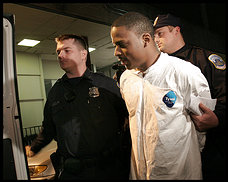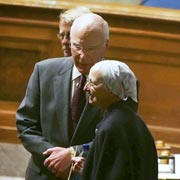Jewish Community Demands Answers in Mugging & Murder of Jewish Journalist, David Rosenbaum !!
|
David E. Rosenbaum - Age 63 Jewish Journalist |
 Michael Hamlin - Age 23 He Claims He Just Took Wallet - Someone Else Hit Rosenbaum With a Pipe ! |
|
Jewish Community
Demands Answers in Aftermath of Mugging Murder Committed By Two
Black Males !
In previous remarks, I have noted that in order to get something done about Black crime, the murdered victim has to be either from the upper-class, someone who is prominent, or it has to be a horrific mass murder. There are three such cases active right now - all of them on the east coast. Jennifer Ross, of Savannah, Georgia, came from the upper-class, David Rosenbaum, of Washington, D.C., was a prominent Jew, and the mass murder occurred in Richmond, VA, in which seven people were murdered.
It must be noted, however, that in the case of David Rosenbaum, the Jewish community has not chosen to openly address the problem of Black crime in the District of Columbia. But, because the Jewish community is so well-organized and so well-represented throughout the local and national government, as well as in the media, one can well bet that there will be a Jewish response to Black crime, although, in all likelihood, it will not be clearly discernable as a Jewish response.
In the Jennifer Ross case, the White business community has formed an ad hoc committed called "Save Our Savannah." This committee is squaring off with the Black mayor and the Black community in its demands to do something about Black crime. Prominent among their demands are more police officers and community participation (speak: Black community participation).
In the David Rosenbaum case, the Jewish community is not squaring off against the Black community, rather, it is recommending that emergency-response procedures be reviewed and changed. Their chief complaints are that it took 23 minutes for an ambulance to arrive at the scene, and that the victim, Mr. Rosenbaum, was not taken to the closest hospital. They also have complaints against the medical personnel at Howard University Hospital, where Mr. Rosenbaum was taken, for not recognizing the severity of his injuries.
In the Richmond Massacre, the perpetrators, Dandridge and Gray, are being investigated for involvement in crimes in various communities in Pennsylvania and Virginia. Authorities from at least five jurisdictions are working together to establish the extent of Dandridge and Gray's involvement and the time-line. The murders are getting comprehensive media coverage (over 700 hits on Google for <dandridge gray richmond harvey tucker>). This could be classified as media activism, as well as activism on the part of authorities, whose job it is to investigate the crimes of Dandridge and Gray. As a result of this extensive media coverage, people will be much more cautious. The Harvey family, for example, had left their door open. You can bet that people are locking their doors more now and buying new and better security locks. But, in this case, the response is only very obliquely against the prevalence of Black crime.
I would categorize the response of the Savannah White community as the healthiest and strongest response, in that they are addressing the root of the problem, i.e., the high, Black-crime rate. The response in the Rosenbaum case is not oriented toward stopping Black crime. Although the Jewish community is organized enough to take the Black mayor of Washington, D.C. and the Black community to task for the high Black crime rate, the Jews have opted to criticize the emergency-response procedures. The lack of, what I would consider to be, appropriate outrage on the part of the Jewish community against Black crime, comes likely from the fact that the Jews have always sided with the Blacks in the Blacks' demands vis-à-vis the White society. This is not a healthy outlook, since more Jews will certainly continue to fall victim to Black crime unless it is controlled.
In the case of the Richmond Massacre (Dandridge & Gray), neither the media nor the community is taking on the problem of Black crime directly. But, because of the extensive media coverage, the average person is able to put two and two together, and respond by making sure that their homes are secure against burglary or, the new Black "crime-of-preference," home invasion. By comparison, random murders not involving a victim from the upper-class, or a prominent person, or not a mass murder, engender little response - even in the community in which they took place. Examples of such murders would be Nigel Marcotte, George L. Wallace, Morgan Young, Betty Jean Sweet, Damon Womble, Robert Osborn, and Eric Mansfield.
To sum up then: although the Jewish community is demanding answers, they are not addressing the problem of Black crime. And, although the murders in Richmond were devastating for the whole community, little is being done directly to address the Black crime situation. As stated above: the healthiest and strongest response is coming from the Savannah White community, whereby they are pressuring the Black mayor and the Black community to finally do something about Black crime.
|
 Marcus Rosenbaum, the victim's brother, speaks to reporters outside David Rosenbaum's house. "What kind of a person could murder somebody for a wallet?" asked Marcus Rosenbaum, who lives in the same neighborhood. |
|
Monday, January 16, 2006; Page A16 |
Memorial Service at the Dirksen Senate Office Building
 Virginia Rosenbaum, center, wife of New York Times journalist David Rosenbaum, who died after a robbery in Washington, DC, is comforted by son, Daniel Rosenbaum, right, and daughter, Dottie Rosenbaum, left, during a memorial service at the Dirksen Senate Office Building on Capitol Hill Friday, Jan. 13, 2006. |
 Senator Patrick Leahy, D-Vermont, greets Virginia Rosenbaum, and other family members of New York Times journalist David Rosenbaum.
|